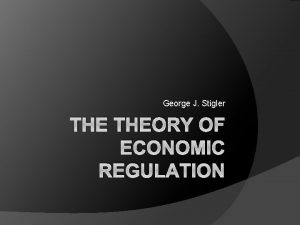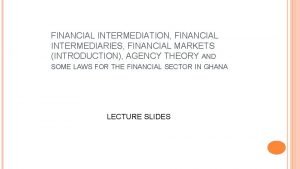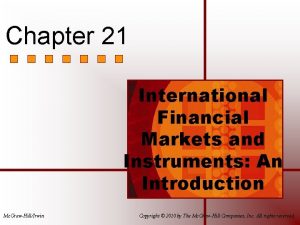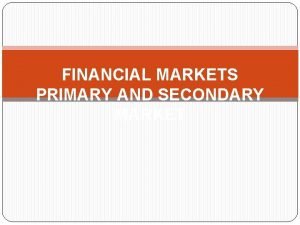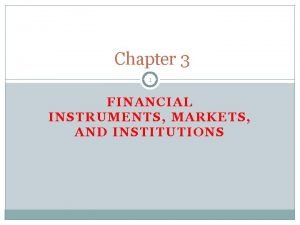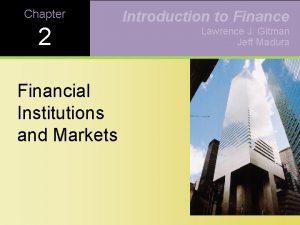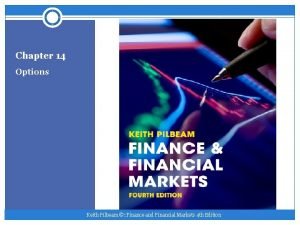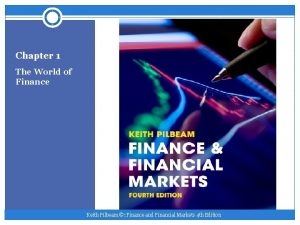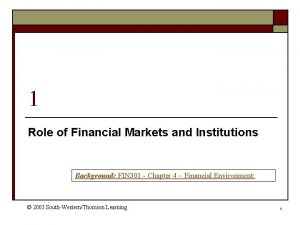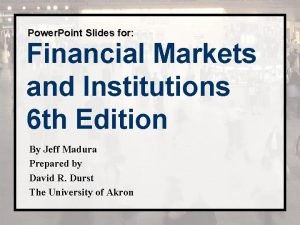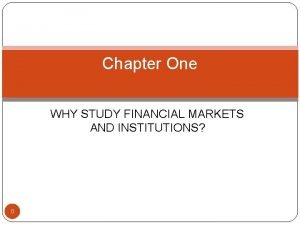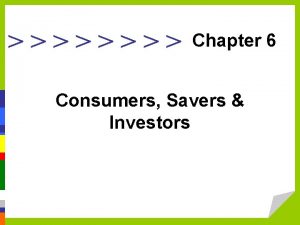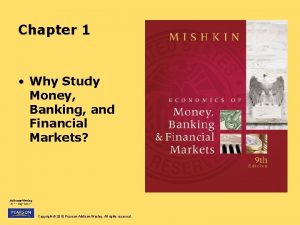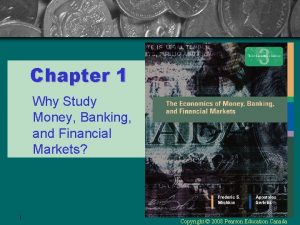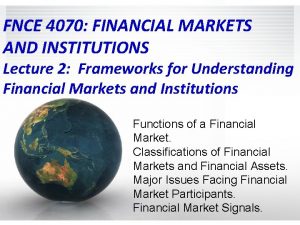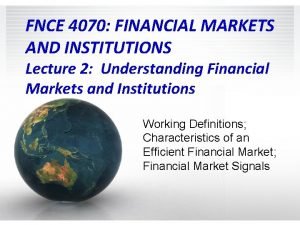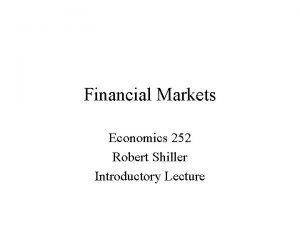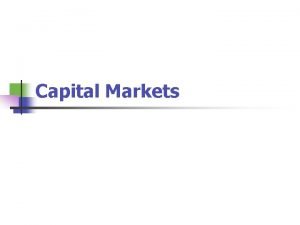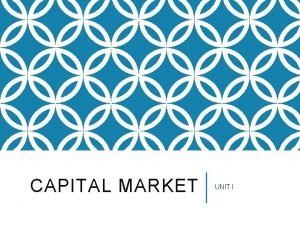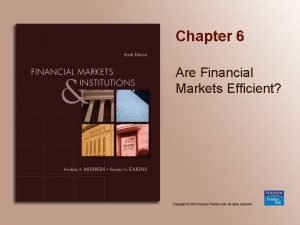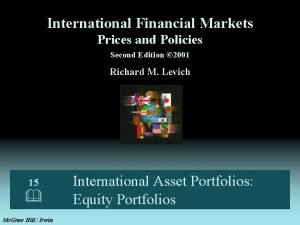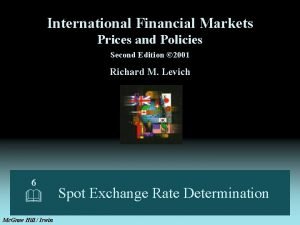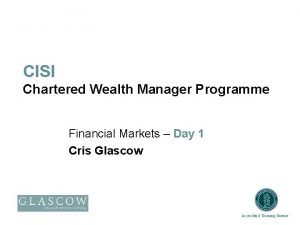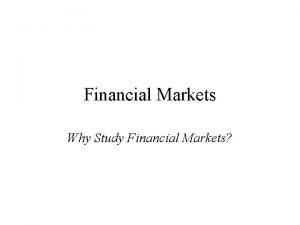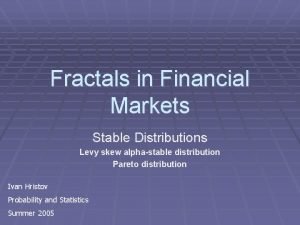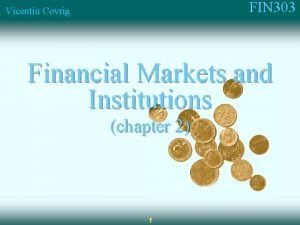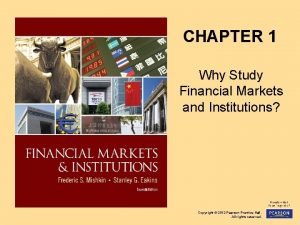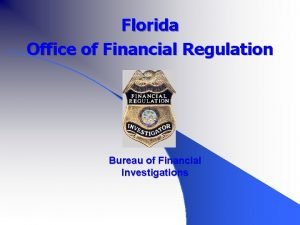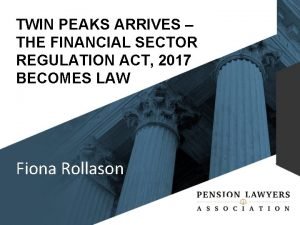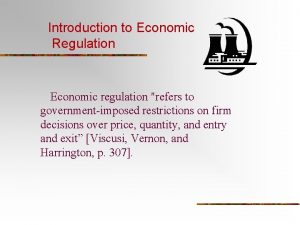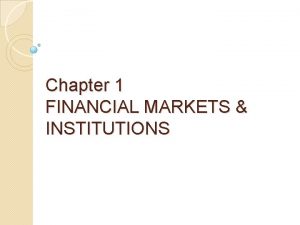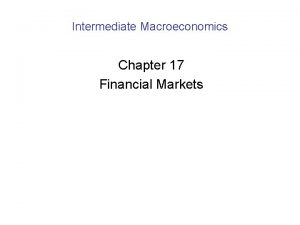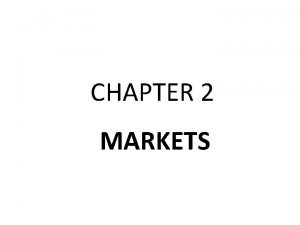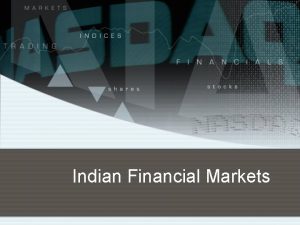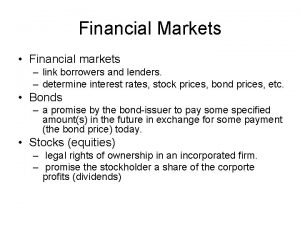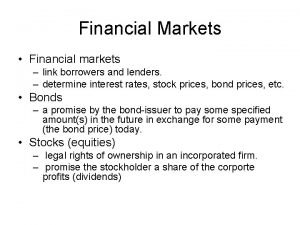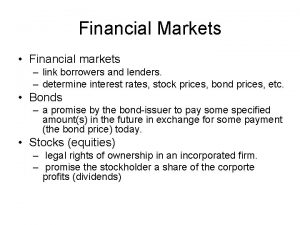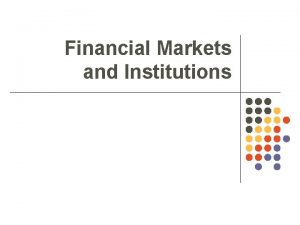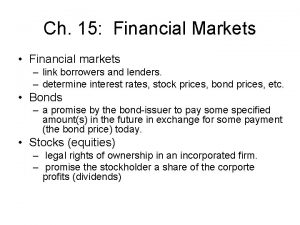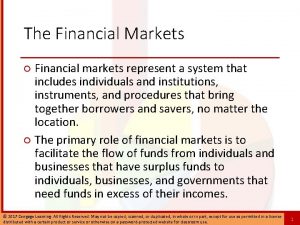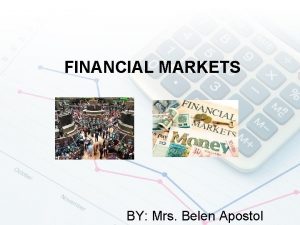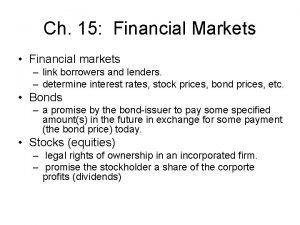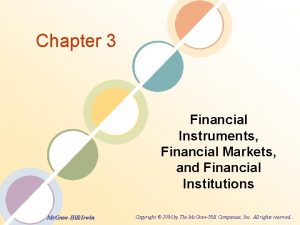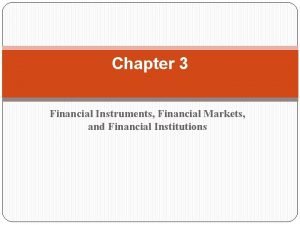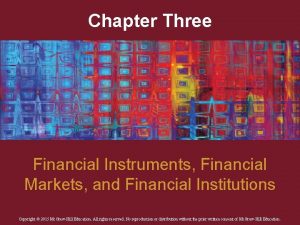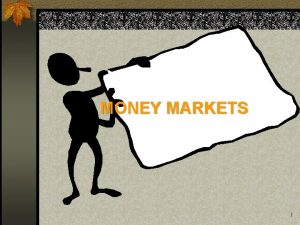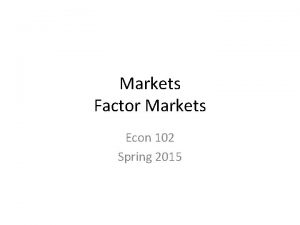Chapter 5 Financial Markets Financial Regulation and Economic



































- Slides: 35

Chapter 5 • Financial Markets, Financial Regulation, and Economic Instability Copyright © 2012 Pearson Addison-Wesley. All rights reserved.

Financial Markets and the IS/LM Model • How can fundamental macroeconomic instability that originates in financial models be modeled using the IS/LM model? • Wealth effect: W↓ Cα↓ IS shifts ← – Stock market crash – Housing bubble bursts – Households borrow too much so that interest payments become burdensome, especially if variable r’s rise • Ease of lending: More loans Cα↓ IS shifts → • New assumption for the LM curve: More than one interest rate – As risk in financial markets↑ difference between the federal funds rate and r charged to households and corporations↑ Copyright © 2012 Pearson Addison-Wesley. All rights reserved. 5 -2

Figure 5 -1 The Log Percent Output Gap for the United States, the Euro Area, and Japan, Index with 2007 = 0, 2000 – 2011 Copyright © 2012 Pearson Addison-Wesley. All rights reserved. 5 -3

Figure 5 -2 The Log Percent Output Gap for the United States in Two Episodes, 1981 -85 and 2007 -10 Copyright © 2012 Pearson Addison-Wesley. All rights reserved. 5 -4

Figure 5 -3 The Log Percent Employment Gap for the United States, 1960 -2010 Copyright © 2012 Pearson Addison-Wesley. All rights reserved. 5 -5

Figure 5 -4 Percent of the Labor Force Unemployed More Than 26 Weeks in Two Episodes, 1981 -85 and 2007 -10 Copyright © 2012 Pearson Addison-Wesley. All rights reserved. 5 -6

Financial Markets and Institutions • Financial markets are organized exchanges where securities and financial instruments are bought and sold. – Direct Finance: When borrowers issue securities directly to lenders – Indirect Finance: When borrowers are matched to lenders indirectly via financial intermediaries, who make loans to borrowers and obtain funds from savers, often by accepting deposits. Copyright © 2012 Pearson Addison-Wesley. All rights reserved. 5 -7

Direct vs. Indirect Finance • What determines whether savers channel their funds through financial markets or through intermediaries? • Direct finance depends on reputation, which limits transactions to large, well-established corporations. • Role of financial intermediaries – Spreading of risk – Efficient collection of information Copyright © 2012 Pearson Addison-Wesley. All rights reserved. 5 -8

Figure 5 -5 The Role of Financial Intermediaries and Financial Markets Copyright © 2012 Pearson Addison-Wesley. All rights reserved. 5 -9

Balance Sheets • A balance sheet sums up a unit’s assets and liabilities – If assets are greater (less) than liabilities, then the unit has a positive (negative) net worth – Represented by a “T” account (see next slide) • The difference between a bank’s assets and liabilities is referred to as the bank’s equity. – Note: The bank’s equity is often called “bank capital” and is also the same as the bank’s net worth – The ratio of a bank’s equity to the value of its assets is used as a measure of the bank’s financial health Copyright © 2012 Pearson Addison-Wesley. All rights reserved. 5 -10

Table 5 -1 The Initial Balance Sheet of the First Reliable Bank Copyright © 2012 Pearson Addison-Wesley. All rights reserved. 5 -11

Bank Assets and Liabilities • Bank assets consists mainly of loans of all types – Examples: Treasury bills, Mortgage-backed securities – Loans are generally risky • Risk is the probability that a given investment or loan will fail to bring the expected return and may result in a loss of the partial or full value of the investment. – Vault cash is also a bank asset • The main liability of banks is the deposits it owes the depositors Copyright © 2012 Pearson Addison-Wesley. All rights reserved. 5 -12

Leverage • Leverage is the ratio of the liabilities of a financial institution to its equity capital – Leverage increases when banks develop methods to grant more loans with their existing equity capital – Leverage magnifies (reduces) profits when the value of an investment is increasing (decreasing) Copyright © 2012 Pearson Addison-Wesley. All rights reserved. 5 -13

Table 5 -2 The New Balance Sheet of the First Reliable Bank After a Decline in Loan and Investment Values of $800 Billion Copyright © 2012 Pearson Addison-Wesley. All rights reserved. 5 -14

Bank Insolvency and Deposit Insurance • A bank is insolvent when its equity is zero or negative – If this happens, a bank is said to “fail” • Should depositors monitor their bank to make sure it has adequate equity? – 1929 -1932: Thousands of banks failed as depositor feared for the solvency of banks and rushed to withdraw their deposits • This is known as a bank run – 1933: FDR established the Federal Deposit Insurance Corporation (FDIC) to insure bank deposits against loss • FDIC insures deposits up to $250, 000 • FDIC also responsible for shutting down insolvent banks – 2009: 140 bank failures Copyright © 2012 Pearson Addison-Wesley. All rights reserved. 5 -15

“Nonbank” Financial Institutions • “Nonbank” financial institutions make loans like banks, however, they do not accept deposits – Source of funds = borrowing from other financial institution – Not regulated by the Fed, so no need to hold reserves – Often hold little equity to boost leverage and thus, profits – Examples: Bear Stearns and Lehman Brothers • Both failed in 2008! Copyright © 2012 Pearson Addison-Wesley. All rights reserved. 5 -16

Table 5 -3 The Balance Sheet of the Exotica & Toxic Fund Copyright © 2012 Pearson Addison-Wesley. All rights reserved. 5 -17

Bubbles and Crashes • An asset bubble is a sustained large rise in the price of an asset relative to its fundamental value, followed by a collapse in prices that eliminates most or all of the initial price gain. – Bubbles originate from an outside shock that changes perceptions about profit opportunities • Main ingredients for bubbles: – High degrees of leverage that boost profit potential – Easy source of credit – In some bubbles, financial innovation makes borrowing easier with complex new financial instruments that are hard to understand • Some important bubbles: – Stock price bubble of 1927 -29 lead to the Great Depression • Cause: Speculation fueled by high allowed levels of leverage – Stock price bubble 1996 -2000 lead to 50% ↓ in stock prices • Cause: Unbounded optimism in “Dot. com” company profit potential – Housing bubble of 2000 -06 lead to the Global Economic Crises • Causes: (1) Very low interest rates from the Fed and (2) financial innovations Copyright © 2012 Pearson Addison-Wesley. All rights reserved. 5 -18

Figure 5 -6 Ratio of S&P 500 Stock Price Index to Earnings of S&P 500 Companies, Index with 1995=100, 1970 -2010 Copyright © 2012 Pearson Addison-Wesley. All rights reserved. 5 -19

Figure 5 -7 Ratio of Housing Price Index to an Index of Rents of Houses and Apartments, Index with 1995=100, 1970 -2010 Copyright © 2012 Pearson Addison-Wesley. All rights reserved. 5 -20

Financial Innovation and the Subprime Mortgage Market • Securitization is the process of combining many different debt instruments like home mortgages into a pool of hundreds and even thousands of individual contracts, and then selling new financial instruments backed by the pool – Example: Mortgage-backed securities (MBS) • Banks that originated loans no longer needed to worry about borrower creditworthiness • The subprime mortgage market consists of borrowers who have some combination of low incomes, unstable employment histories, and poor credit records – Risky loan nickname: “NINJA Loans” = “No Income No Job No Assets” – Thrived as long as the Fed kept interest rates low and granting home loans to risky borrowers was in harmony with overall government policy • In mid-2004, Fed raised short term rates, and many subprime loans began to “reset” • Borrowers fell behind mortgage payments foreclosures followed Copyright © 2012 Pearson Addison-Wesley. All rights reserved. 5 -21

Why Buy Risky Subprime MBS’s? • Individual investors were misled – Security ratings agencies (like Moody’s and Standard and Poors) gave unrealistic “AAA” ratings to subprime debt • Why did financial institutions buy MBS’s? – Ignorance: No previous housing bubble in history – Greed: Fees and bonuses fueled additional risk-taking Copyright © 2012 Pearson Addison-Wesley. All rights reserved. 5 -22

The End of the Housing Bubble • Risk-taking was fueled by the premise that housing prices would increase indefinitely • But Fed raised the federal funds rate from 1. 0% to 5. 25% between mid-2004 to mid-2006 – Adjustable rate mortgages interest rates rose – Families had to choose between defaulting on mortgages vs. cutting other household expenses – New loans became more difficult to receive Housing demand↓ – “Flippers” became fearful and started to sell – Result: Housing prices plummeted! • Housing price collapse Onset of financial crisis – Value of MBS collateral↓ MBS value↓ Financial institutions failed Copyright © 2012 Pearson Addison-Wesley. All rights reserved. 5 -23

Figure 5 -8 A Negative Demand Shock Followed by a Monetary Policy Stimulus Copyright © 2012 Pearson Addison-Wesley. All rights reserved. 5 -24

Figure 5 -9 An Unusually Large Negative Demand Shock Cannot BE Fully Offset by Monetary Policy Copyright © 2012 Pearson Addison-Wesley. All rights reserved. 5 -25

The Term and Risk Premiums • The term premium is the average difference over a long period of the interest rate on long-term bonds and the interest rate on the short-term federal funds rate – The Fed can push the federal funds rate to zero, but not the long term bond interest rate – Long term interest rates are generally higher than short term interest rate • Compensates for the risks of investing money for many years (e. g. inflation) • Consumer and firms borrowing at the long term interest rate are riskier borrowers than the government • The risk premium is the difference between the corporate bond rate and the risk-free rate of Treasury bonds having the same maturity – Gives the additional interest bond purchasers require on home mortgages and corporate debt – Provides a measure of financial panic Copyright © 2012 Pearson Addison-Wesley. All rights reserved. 5 -26

Figure 5 -10 The Federal Funds Rate, the Ten-Year Treasury Bond Rate, and the Baa Corporate Bond Rate, 1987 -2010 Copyright © 2012 Pearson Addison-Wesley. All rights reserved. 5 -27

Figure 5 -11 The Risk Premium and the Term Premium Make a Bad Situation Even Worse Copyright © 2012 Pearson Addison-Wesley. All rights reserved. 5 -28

The IS/LM Summary of the Causes of the Global Economic Crisis • Causes that pushed the IS curve to the left – Negative wealth effect from the collapse of the housing bubble C↓ – Negative wealth effect from the 50% decline in the stock market C↓ – End of cash-out mortgage refinancing C↓ – Growing unwillingness of financial intermediaries to grant loans I↓ • Causes that prevented a monetary stimulus from eliminating the output gap – Negative interest rate required, but Fed limited to lowering i to zero – Businesses cannot obtain financing at the federal funds rate, they must borrow at the higher long term i – Higher risk premium lead to higher long term i Copyright © 2012 Pearson Addison-Wesley. All rights reserved. 5 -29

New Fed Instrument: Quantitative Easing • Before: Fed’s policy instrument was to target the federal funds rate – Two problems • “Zero Lower Bound: ” The federal funds rate cannot be pushed below zero • Firms do not borrow at the federal funds rate, so even a low rate may not boost investment • New method to ease the crisis: Quantitative Easing occurs when a central bank purchases assets for the purpose of increasing bank reserves (not lowering short-term interest rates) – Provided liquidity to markets for distressed financial assets like MBS’s, which improved balance sheets of suffering financial institutions – Radically changed the balance sheet of the Fed (see next two slides) • IS/LM model interpretation – Quantitative easing increases demand for long term and risky financial assets, thereby reducing the term and risk premiums Copyright © 2012 Pearson Addison-Wesley. All rights reserved. 5 -30

Table 5 -4 The Balance Sheet of the Federal Reserve, January 9, 2008 Copyright © 2012 Pearson Addison-Wesley. All rights reserved. 5 -31

Table 5 -5 The Balance Sheet of the Federal Reserve, August 11, 2010 Copyright © 2012 Pearson Addison-Wesley. All rights reserved. 5 -32

Figure 5 -12 Major Components of Federal Reserve Assets and Liabilities, January 2008 to August 2010 (1 of 2) Copyright © 2012 Pearson Addison-Wesley. All rights reserved. 5 -33

Figure 5 -12 Major Components of Federal Reserve Assets and Liabilities, January 2008 to August 2010 (2 of 2) Copyright © 2012 Pearson Addison-Wesley. All rights reserved. 5 -34

How The Financial Crisis Became Worldwide • U. S. subprime housing market estimated at $250 B – World decline in GDP from 2007 -09 = 20 times $250 B – World decline in stocks equaled 100 times initial shock • Why such an amplification of the subprime shock? – Dramatic jump in interest rate risk premium lead to higher costs of doing business worldwide • Global slowdown in investment and employment • Slowdown in lending by financial intermediaries worldwide – Many foreign financial institutions invested heavily in U. S. subprime debt • These investments were financed by borrowing short-term low-interest USD loans • When short-term loans evaporated, these financial institutions could not renew loans • But value of their MBS investments collapsed crisis exacerbated Copyright © 2012 Pearson Addison-Wesley. All rights reserved. 5 -35
 Why study financial market
Why study financial market George stigler the theory of economic regulation
George stigler the theory of economic regulation Financial markets and institutions jeff madura ppt
Financial markets and institutions jeff madura ppt Financial intermediaries ppt
Financial intermediaries ppt What is financial intermediation
What is financial intermediation International financial markets and instruments
International financial markets and instruments Savers and investors role in financial markets
Savers and investors role in financial markets Methods of floatation in primary market
Methods of floatation in primary market Financial markets and the allocation of capital
Financial markets and the allocation of capital Foreign exchange and international financial markets
Foreign exchange and international financial markets Basic flow of funds through the financial system
Basic flow of funds through the financial system Madura j. financial markets and institutions
Madura j. financial markets and institutions Pilbeam k. finance and financial markets
Pilbeam k. finance and financial markets Pilbeam finance and financial markets
Pilbeam finance and financial markets Role of financial markets and institutions
Role of financial markets and institutions Madura j. financial markets and institutions
Madura j. financial markets and institutions Why study financial markets and institutions
Why study financial markets and institutions Chapter 6 consumers savers and investors answer key
Chapter 6 consumers savers and investors answer key Why study money banking and financial markets
Why study money banking and financial markets Why study money banking and financial markets
Why study money banking and financial markets Economic development vs economic growth
Economic development vs economic growth Classification of financial markets
Classification of financial markets Classification of financial markets
Classification of financial markets Financial markets shiller
Financial markets shiller Classification of financial markets
Classification of financial markets Classification of financial markets
Classification of financial markets Are financial markets efficient
Are financial markets efficient Levich international financial markets
Levich international financial markets International financial markets levich
International financial markets levich Chartered wealth manager cisi
Chartered wealth manager cisi Classification of financial markets
Classification of financial markets Fractals in financial markets
Fractals in financial markets Well functioning financial markets
Well functioning financial markets Why study financial markets
Why study financial markets Consumer financial services pensacola fl
Consumer financial services pensacola fl Twin peaks financial regulation
Twin peaks financial regulation

